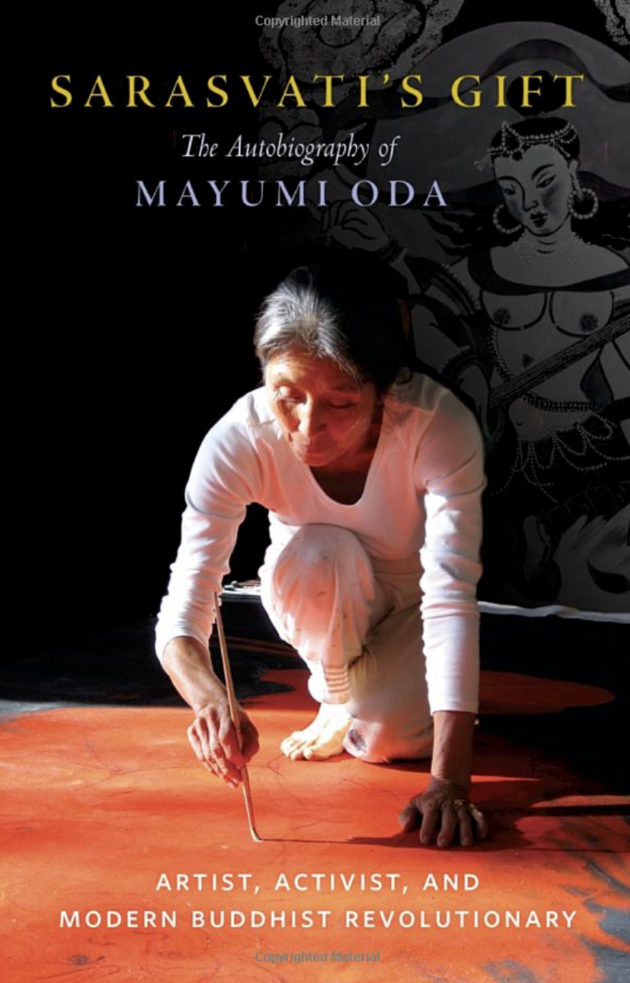

Sarasvati’s Gift: The Autobiography of Mayumi Oda, Shambhala 2020, 160pp.
The life trajectory of Japanese American artist, activist, feminist and “Modern Buddhist Revolutionary” Mayumi Oda is well known to longtime readers of Kyoto Journal (2011[i] and 2012[ii]) through first-person interviews and images of Hindu, Shinto, Buddhism, Taoism, Hawaiian and Christian deities to voluptuous women on penny-farthing bikes and young mothers. Called the “Matisse of Japan,” Her iconic portraits reflect the spiritual intimates who have influenced her conscious efforts to put the world in balance, as expressed in her latest book, Sarasvati’s Gift: The Autobiography of Mayumi Oda (Shambhala, 2020)[iii].
Among them, none has been so influential and loyal as the Indian river goddess Sarasvati, also known in Japanese Shugendo Buddhist practice as Benten / Benzaiten. Each of the emanations of Sarasvati, counted among the 28 images reproduced in full color, is accompanied by a description of key attributes that inspired and even empowered Oda’s lifetime of activism opposing nuclear power and in support of sustaining natural environment and indigenous culture.
Sarasvati, the goddess of art, music, poetry and learning, was Mayumi’s favorite deity since she was a little girl growing up in a sophisticated, culturally active Tokyo family, because “… she was so directly understandable to a child.” Mayumi recounts the difficulties of family life after the American fire-bombing of Tokyo and devastation thereafter, leading up to the Tohoku 2011 disaster. As an upcoming artist she had a burning need to leave Japan for the USA where she might find a broader perspective on a life of free expression. Oda’s strategy was clear: “I think it’s time for me to really start showing that feminizing through my art, so that we can go back to that society that really cares, for the future, for life, and the children, the land, more compassionate and more loving.”
The book details her interactions with many of the 20th and 21st centuries’ contemporary thinkers, artists, writers, religious activists and leaders, as well as gives glimpses of her family life. Throughout, she sought support of the powerful spiritual beings whose images she revealed with deep reverence.
In 1991, “I felt okay about leaving my painterhood for a while, in order to use my creativity to protect life, in this way embodying the meaning of the painting.”
In 1997, Oda depicted the goddess as a full-figured woman playing a lute-like instrument, with the sun and moon as the sound holes. “This Sarasvati wears a crown of a white coiled serpent. Two dragons behind her hold the three treasures of Buddhism: Buddha, Dharma and Sangha.” Two turtles swim in her waters from which her throne of a lotus grows.
“In 1999, I received a message from Sarasvati to fight against the nuclear disaster in Japan. I spent five years working as an activist. It was so difficult, and afterward I came back to the studio to paint.”
In 2004, seeking revitalization, she depicted the goddess with the traditional eight arms, each hand from which she placed different means of fighting and protection: bow, sword, ax, noose, arrow, three-prong halberd, single-arm vajra and ring. Oda states that she used these tools to fight nuclear energy in Japan. “I felt like I had to use all these arms myself.” Literally “armed” with inspiration, she pursued a plutonium-free non-GMO future internationally.
In 2009 she painted “Four-armed Sarasvati With Pearls”, an image harkening back to the original one of more Hindu tradition. The goddess holds a vina, pearl mala and a sutra while riding a white swan on the Sarasvati River, much like Mayumi does in her morning chanting practice invoking Sarasvati (sans swan). “If Sarasvati considers it a proper wish, she will grant it for me in three days.” Through her daily meditation, she hopes to “… transform our fear-based civilization entering a more compassionate and creative era. We need patience. Sarasvati telling me we can succeed.”
Today, she channels her energies to painting in her studio on Gingerhill Farm, a sustainable agrarian community she founded in Kealakeakua Hawai’i. Her interests focus on learning traditional Hawai’ian cultural practices that respect the land and its vital indigenous spirits. I think as an artist … there’s very little I can do, but at least I’ve been painting the Goddesses, I’ve been painting the female …”
[i] Awakening the Goddess Within: An Interview with Mayumi Oda. October 2, 2011. https://www.kyotojournal.org/conversations/awakening-the-goddess/
[ii] Energy of change, Feminization and New Birth of Japan. June 25, 2012. https://www.kyotojournal.org/online-special/mayumi-oda-on-energy-of-change-feminization-and-new-birth-of-japan/
